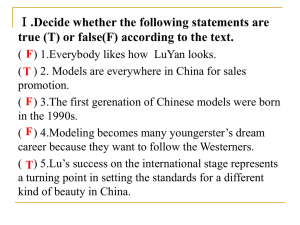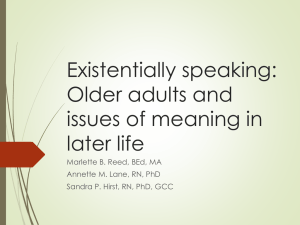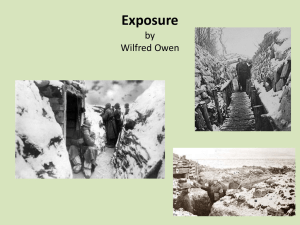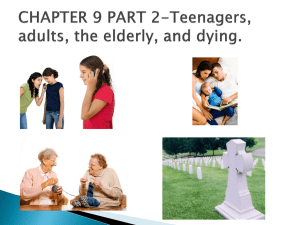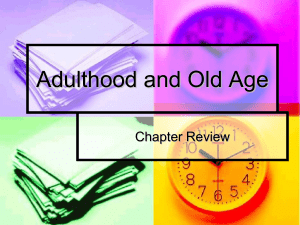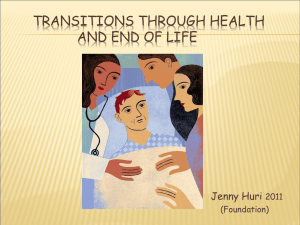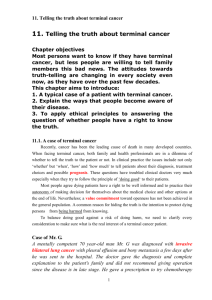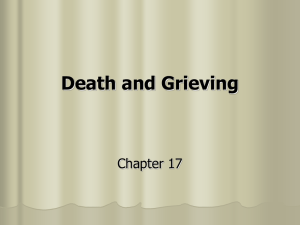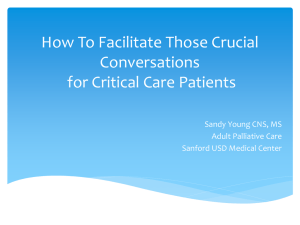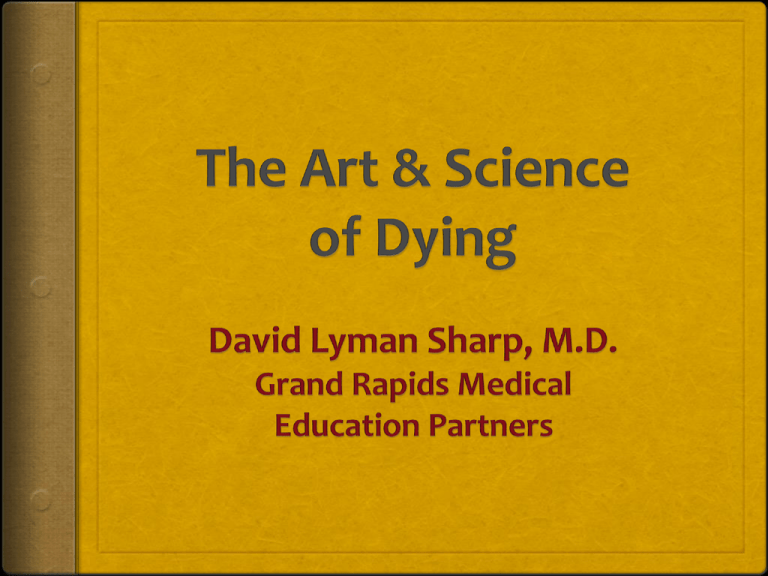
David L. Sharp, M.D.
father killed in MVA when I was 4 years old
Inspiration to medical career – my Uncle Fred Zaidan
Raised/educated at Girard College in Philadelphia, PA
University of Pittsburgh – B.S. & M.D.
married to Babs – 4 children – 8 grandchildren
Pilot Family Medicine residency in NJ – lived there 19 yrs
moved to GRR when daughter entered Hope College
office-based family physician most of career
boards in Family Medicine & Hospice and Palliative Care
spiritual gift: mercy
physician for Southwest 110 Team, Hospice of Michigan
Dr. Dave at the woodpile,
2004
Ben Casey, M.D.
Creation…
according to Genesis
Genesis 2:7
“Then the Lord God formed man
from the dust of the ground, and
breathed into his nostrils the
breath of life; and the man
became a living being.
Creation….
according to the
Boston Planetarium
“…and out from the primordial
ooze came life…”
“… and it evolved into many
species…”
“… and along came ‘man’…”
Death - Wikipedia
Death is the permanent termination of the biological
functions that sustain a living organism.
Phenomena which commonly bring about death
include:
Old age
Predation
Malnutrition
Disease
Accidents or trauma resulting in terminal injury
Death - Wikipedia
Death is the permanent termination of the biological
functions that sustain a living organism.
Phenomena which commonly bring about death
include:
Old age
Predation
Malnutrition
Disease
Accidents or trauma resulting in terminal injury
Death - Wikipedia
Death is the permanent termination of the biological
functions that sustain a living organism.
Phenomena which commonly bring about death
include:
Old age
Predation
Malnutrition
Disease
Accidents or trauma resulting in terminal injury
how long is “Life?”
Genesis 6:3
“Then the Lord said, ‘My spirit
shall not abide in mortals
forever, for they are flesh; their
days shall be one hundred
twenty years.’”
Ashley Montagu
“The idea is to die young
… as late as possible.”
cell death
hypoxia
acidosis
entropy
apoptosis
free radicals
toxic milieu
tumor growth
dying process involves:
discovery
insight
adjustment to constantly changing
circumstances
personal reaction
dealing with others’ reaction to one’s illness
and decline
developing strategies to avoid destruction of
“self”
creating a map to the end
“What would be left undone if
you died today?”
“How can you live most fully in
whatever time is left?”
“What are your goals for
yourself?”
what is “to accomplish?”
The FIVE THINGS;
“I forgive you”
“Forgive me”
“Thank you”
“I love you”
“Good-bye”
history: The Spanish Death
A book titled “Agonia del Transito de la
Muerte” (Agony of the Passing of Death)
written in 1537 by Alejo de Venegas,
elaborated on the "Spanish Death.”
He advised that friends and relatives should
gather around the dying person. These
treatises might have been a plausible, but
distant, prelude to the modern hospice
movement.
Toda MFS. Ars moriendi, European J Pall Care, 1997:
4(5):164-168.
what is “a good death?”
“To those who know, no
explanation is necessary; to
those who don’t know, no
explanation is sufficient.”
“Dying Well - Peace & Possibilities
at the End of Life” – p. 31
Ira Byock, M.D.
fears associated
with death and dying:
“I don’t want to die in pain…”
“I don’t want to suffer…”
“I don’t want to be a burden on my family…”
“I don’t want to leave my family with
debts…”
“I don’t want to go through all our
savings…”
David Gerrold
“Life is hard. Then you die. Then
they throw dirt in your face. Then
the worms eat you.
Be grateful it happens in that
order.”
Elizabeth Kübler-Ross
The Five Stages of Dying:
Denial
Anger
Bargaining
Depression
Acceptance
Death - Wikipedia
Death is the permanent termination of the
biological functions that sustain a living organism.
Phenomena which commonly bring about death
include:
Old age
Predation
Malnutrition
Disease
Accidents or trauma resulting in terminal injury
defining “permanent”
conditions which mimic death:
coma
hypoglycemia
hypothermia
bradycardia
hypoxia
electric shock
drug overdose
EEG, multimodality evoked potentials, etc. - helpful in
determining “brain death”
the slippery new slope
death of the neo-cortex is being associated with the
permanent loss of personhood
Information-theoretic death – “the destruction of
information within a human brain (or any cognitive
structure capable of constituting a person) to such
an extent that recovery of the original person is
theoretically impossible by any physical means”
WOW! We aren’t there if someone erases our hard
drive!
“The Princess Bride”
Billy Crystal, playing Mad Max:
“Your friend is not dead. He is only mostly
dead.”
Mad Max proceeded to resuscitate our
hero into a weakened but fully brain-alive
state, and he eventually recovered all
bodily functions as well.
Role of EEG’s in death determination
walking the fine line…
prolonging life
allowing natural death
hastening death
terminal sedation
euthanasia
dysthanasia
assisted suicide
plumbing the depths
“How are you feeling within yourself?”
“How do you feel about what’s
happening to you?”
Loss of function
Dependency
Crumbling previous relationships
Leonardo da Vinci
“While I thought that I was
learning how to live, I have been
learning how to die.”
questions for the family
“Did we make the right decisions?”
“Did we give up too soon or hang on
too long?”
“Was there anything else we should
have done?”
“Did we seize every opportunity, take
every action, for a loving, peaceful
end?”
W. Somerset Maugham
“Death is a very dull, dreary affair,
and my advice to you is to have
nothing whatsoever to do with it.”
“being a burden”
Families deny that their loved one is a burden
Often for them it is a sacred opportunity to
be of service to a loved one who has
served them in the past.
It becomes precious time together and
brings families closer to one another.
The burden is rarely too heavy.
“it may be sad, but it is something we must
do….”
caring for loved ones…
the evolution
first, a satisfaction
then, a joy
after that, a privilege
and, finally, a sacred honor
Hmmmmm….
Allen Stewart Konigsberg
1935-????
Woody Allen:
“I’m not afraid to die. I just don’t
want to be there when it
happens.”
Death - Wikipedia
Death is the permanent termination of the biological
functions that sustain a living organism.
Phenomena which commonly bring about death
include:
Old age
Predation
Malnutrition
Disease
Accidents or trauma resulting in terminal injury
nutrition
A topic that comes with cultural and ethical
“baggage”
And yet – we must all die of SOMETHING… why
not malnutrition
What ELSE will one die of, if not malnutrition?
sepsis
electrolyte imbalance
cardiac arrhythmia
blood loss/anemia
hypoxia
inability to eat
“Dying of a progressive inability to eat is
probably one of the most natural and
physiologically gentle ways to expire… Hunger
is rarely, if ever, a source of discomfort… Same
is true of thirst… Hospice patients who are
dehydrated are regularly asked if they are
thirsty; most answer ‘no,’ but those who say
‘yes’ are consistently and fully relieved by having
their mouth and throat moistened.”
Ira Byock, “Dying Well,” p. 166
moral considerations
Nutrition is a decision – living will stipulations
patient autonomy – to eat or not eat is a right
Catholic Church supports nutritional efforts for patients in
a persistent vegetative state
In a terminally-ill patient, morally and ethically, to
withdraw or withhold nutrition is no different than any
other test or treatment
A tough decision point to reach – takes time – a FULL
CONSENSUS is needed – clear and frequent
COMMUNICATION necessary – no rush
Pope Paul II, 2004
"The sick person in a vegetative state, awaiting
recovery or a natural end, still has the right to basic
health care (nutrition, hydration, cleanliness,
warmth, etc.), and to the prevention of
complications related to his confinement to bed . . .
Death by starvation or dehydration is, in fact, the
only possible outcome as a result of their
withdrawal. In this sense it ends up becoming, if
done knowingly and willingly, true and proper
euthanasia by omission." -- Pope John Paul II, 2004
when it becomes futile…
"Medically assisted nutrition and hydration become
morally optional when they cannot reasonably be
expected to prolong life and when they would be
excessively burdensome for the patient or would cause
significant physical discomfort, for example, resulting
from complications in the use of the means employed,"
said Haas, quoting the U.S. bishops' Directives. "For
instance, as the patient draws close to inevitable death
from an underlying progressive and fatal condition,
certain measures to provide nutrition and hydration may
become excessively burdensome and therefore not
obligatory in light of their very limited ability to prolong
life and provide comfort.” John Haas, Catholic Ethicist
When is it “futile?”
Declaration of “futile care” needs consensus:
patient (either in person or by proxy in living will)
family or significant others
medical care team
spiritual advisor
If all four are NOT in agreement, it is best to
continue treatment or perform the test or
procedure
Hospice/Palliative Care consultation can be helpful
to resolve differences or misunderstandings
stopping eating
and drinking
hunger pains – first day or two – not all patients
dry mouth – easily assuaged with swabs
ice chips and sips of water prolong dying process
but may be necessary for caregivers’ comfort
“sleepier and sleepier”
2-5 days semi-comatose
2-5 days fully comatose – hearing last sense to lose
apnea, followed by cardiac arrest, or the other way
“thirst”
For the dying, this does not have the same
connotation of “needing to drink substantial
amounts of fluid”
Consistently relieved in the dying person by
having their mouth and throat moistened
Ice chips and sips of fluids often culturally
necessary, but delay natural death
transcendence vs.
Terminal restlessness
Dying person appears to be losing
connections with current reality
May be connecting to another dimension or
absolute
Focusing on internal processes and concerns
beyond their immediate world
Appears like confusion – we often call it
visual or auditory hallucinations
Developing a new spiritual identity?
Elizabeth Kübler-Ross
“For me, death is a graduation.”
Death - Wikipedia
Death is the permanent termination of the biological
functions that sustain a living organism.
Phenomena which commonly bring about death
include:
Old age
Predation
Malnutrition
Disease
Accidents or trauma resulting in terminal injury
Death - Wikipedia
Death is the permanent termination of the
biological functions that sustain a living organism.
Phenomena which commonly bring about death
include:
Old age
Predation
Malnutrition
Disease
Accidents or trauma resulting in terminal injury
Homostenosis…
the closing off of life
Symptoms and Signs
Physical Findings
Three Stages of Actively
Dying
Homostenosis
SYMPTOMS/ SIGNS:
debility – fatigue/asthenia
dysphagia - odonophagia
cachexia/anorexia - weight loss, wasting,
decreased Body Mass Index (BMI)
anxiety, delirium and terminal restlessness
fluid shifts - localized edema, ascites, anasarca
Homostenosis
SYMPTOMS/SIGNS:
pain - physical, social, psychological and spiritual
sensorium - awake, semi-comatose,
obtundation, comatose
nausea and vomiting - emesis, hematemesis
intestinal dysfunction – gastrostasis,
constipation, malignant obstruction
Homostenosis
SYMPTOMS/SIGNS:
Near Death Awareness (“NDA”) - surreal
auditory and visual hallucinations
renal shutdown - oliguria, incontinence,
retention, bladder spasms
shock state - cardiovascular collapse, pulsus
alternans
Respiratory failure - dyspnea, DOE, orthopnea,
paroxysmal nocturnal dyspnea, wheezes, etc.
Homostenosis:
Pre-mortem, Stage I
Stage I - Early active phase physical symptoms/signs:
dysphagia and lack of interest in fluids/food
progressive fatigue and weakness, unable to bear
weight
emotional withdrawal
tachycardia or bradycardia
tachypnea or bradypnea
hypotension (mild)
drowsy to stuporous
Homostenosis:
Pre-mortem, Stage II
Stage II - Active phase physical signs:
tachycardia > 120/min,
hypotension - BP <80 mmHg systolic, < 40 mmHg
diastolic
early cyanosis, cool extremities,
oliguria < 500 ml/day, concentrated, tea color
profound weakness, usually bedbound - asthenia
Homostenosis:
Pre-mortem, Stage II
Stage II - Active phase physical signs:
unable to eat or drink without choking: oropharyngeal dysfunction, usually moderate to severe
enough to cause aspiration
hypothermia, hyperthermia
tachypnea, bradypnea, Cheyne-Stokes breathing,
unable to clear secretions in hypopharynx/tracheobronchial areas (sonorous rhonchi = “death rattle”)
Homostenosis:
Pre-mortem, Stage II
Stage II – Active Phase physical signs:
altered sensorium - very drowsy to semi-comatose
mandibular breathing - respirations with mandibular
movement – “RMM”
delirium, terminal restlessness and “NDA”
pallor of nose and helix (top) of ear; flaccid pinna of
ear (earlobe)
Physical Findings:
flaccid pinna of ear (earlobe)
Homostenosis:
Pre-mortem, Stage III
Stage III - Imminent Death – Actively Dying
findings of Stages I and II – PLUS:
increased RMM
cool mandible
Cheyne-Stokes breathing with prolongation of apneic
phase
pulsus alternans
Homostenosis
Pre-mortem, Stage III
Stage III – Actively dying
awake, very drowsy or comatose
patellar mottling
increased cyanosis and mottling – lips, fingers
drooping of the naso-labial fold
forehead bossing (relaxed forehead/face)
Physical Findings:
patellar mottling
Homostenosis:
Pre-mortem, Stage III
Stage III – Actively dying
hyperextension of the neck with tense
sternocleidomastoid muscle
relaxation of the anal sphincter
absent bowel sounds
“Kennedy Terminal Ulcer”
loss of both radial pulses
Physical Findings:
hyperextension of the neck
with tense
sternocleidomastoid muscle
Physical Findings:
Kennedy Terminal Ulcer (1)
Physical Findings:
Kennedy Terminal Ulcer (2)
Physical Findings:
Kennedy Terminal Ulcer (3)
Symptoms Associated
with Actively Dying (1)
noisy and moist breathing 56 %
restlessness/agitation 42%
pain 42%
urinary incontinence 32 %
dyspnea 22%
Symptoms Associated
with Actively Dying (2)
urinary retention 22%
nausea and vomiting 14 %
sweating
14 %
jerking, twitching, plucking
%
confusion 8 %
12
T Morita, et al: A prospective study on the dying process
in terminally ill cancer patients.
Am J Hospice and Palliative Care. 1998;15:4:217-222.
1. clouding of consciousness
8% are awake in the last 6 hrs
2. death rattle
49% - present >24 hrs before death
3. respirations with mandibular movement
68% within 6 hrs of death
4. cyanosis of extremities
81% within 6 hours of death
5. pulselessness of the radial artery
87% within 6 hours of death
Median time until death following:
Death Rattle: 57 hours (+ 23)
Respiratory Mandibular Movement:
7.6 hours (+ 2.5)
Cyanosis: 5.1 hours (+ 1)
Loss of radial pulse: 2.6 hours (+ 1)
If all four are present,
we are down to “hours”
death rattle
respiratory mandibular
movement
cyanosis and/or mottling
loss of both radial pulses
needed transformation –
an American cultural shift…
away from the denial of death as an essential
part of life
away from dying as an inevitable emotional
distress and barely avoidable physical
suffering
toward an understanding of dying as a part
of full, even healthy, living
toward accepting care for the dying as a
valuable part of the life of the community
Americans with increased
chance of dying in pain
non-English-speaking
Black or African-American
Hispanic
poor
elderly
female
As a caring community,
we will say to the dying:
“We will keep you warm and dry and
clean. We will help you with pain and
elimination. We will offer you food and
drink, if you want it. We will be with
you. We will bear witness to your
sorrows, triumphs and
disappointments. We will listen to the
stories of your life, and we will
remember the story of your passing.”
perseverance
Physical distress among the dying can
always be alleviated
Medical care for the dying only fails
when we give up
Pain is only “uncontrollable” until we
control it
Hospice Team Approach – consult your
Team – many heads and points of view
solve tough problems
A life philosophy…
“Don’t worry about the
mule going blind, just
load the wagon.”
thanks to…
Ira Byock, M.D., internist and hospice physician,
Missoula, Montana, author of “Dying Well – Peace
and Possibilities at the End of Life,” 1997, Past
President of AAHPM
Wikipedia, to whom I gave $100
John A. Mulder, M.D. of Grand Rapids, MI and
Alexander Peralta, Jr., M.D. of Duncanville, TX, for
the backbone of “Homostenosis”
www.brainyquote.com
Stages of Life
Growing up
Growing old
Growing on
Abraham Maslow,
the fancy version:
Growing up – intrapersonal
Growing old – interpersonal
Growing on – transpersonal
(or transcendent)
Suicide
Often a response to unbearable
pain
Response to “nothing else can be
done”
“Your case is hopeless… there’s
nothing else we can do for you.”
Helen Keller
“Protection in the long run is
no safer than outright
exposure. Life is either a daring
adventure or nothing at all.”
Caregivers’ Burden
20% - family member had to quit work,
delay their own medical care or make
another major life change to provide
care for dying person
29% - experienced loss of most, or all, of
their major source of income
31% - reported loss of most or all family
savings
Gerald May
psychologist and theologian
“Grief is neither a disorder nor a
healing process; it is a sign of health
itself, a whole and natural gesture of
love. Nor must we see grief as a step
towards something better. No matter
how much it hurts – and it may be the
greatest pain in life – grief can be an
end in itself, a pure expression of love.”
Suffering
Physical pain from disease, plus
Emotional and psychological pain that comes
with losing all a person has been or hoped and
imagined they might someday be
EQUALS TOTAL PAIN… THE LOSS OF
PERSONHOOD
Loss of meaning and purpose in life
“He who has a why to live, can bear almost any
how.” Friedrich Nietzsche


